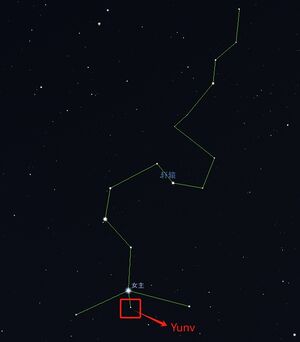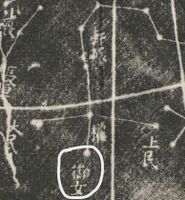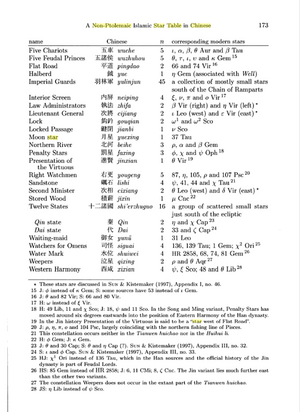Yunü: Difference between revisions
No edit summary |
|||
| Line 7: | Line 7: | ||
The two terms "Nüyu" and "Yunü" have the same meaning, with the order of the two syllables being reversed. |
The two terms "Nüyu" and "Yunü" have the same meaning, with the order of the two syllables being reversed. |
||
{| class="wikitable" |
|||
| ⚫ | |||
|+ |
|||
!Star Names or Orders(Traditional/Qing) |
|||
!Rufus and Tien |
|||
Suzhou map<ref>Rufus. W. C., Hsing-chin Tien. ''The Soochow Astronomical Chart''. Ann Arbor: University of Michegan Press. 1945, Pp23-24.</ref> |
|||
!Ho PENG YOKE<ref>P.-Y. Ho, “Ancient And Mediaeval Observations of Comets and Novae in Chinese Sources,” ''Vistas in Astronomy'', 5(1962), 127-225.</ref> |
|||
!Yi Shitong<ref>Yi Shitong伊世同. ''Zhongxi Duizhao Hengxing Tubiao''中西对照恒星图表1950. Beijing: Science Press.1981: 116-117.</ref> |
|||
!Pan Nai<ref>Pan Nai潘鼐. ''Zhongguo Hengxing Guance shi''中国恒星观测史[M]. Shanghai: Xuelin Pree. 1989. p222.</ref> |
|||
based on Xinyixiangfayao Star Map |
|||
!SUN X. & J. Kistemaker<ref>Sun Xiaochun. & Kistemaker J. ''The Chinese sky during the Han''. Leiden: Brill. 1997, Pp241-6.</ref> |
|||
Han Dynasty |
|||
!Boshun Yang<ref>B.-S. Yang杨伯顺, ''Zhongguo Chuantong Hengxing Guance Jingdu ji Xingguan Yanbian Yanjiu'' 中国传统恒星观测精度及星官演变研究 (A Research on the Accuracy of Chinese Traditional Star Observation and the Evolution of Constellations), PhD thesis, (Hefei: University of Science and Technology of China, 2023). 292.</ref> |
|||
|- |
|||
|[[Yunü]]/17th |
|||
|pi/31 Leo |
|||
|pi/31 Leo |
|||
|31 Leo |
|||
| 31 Leo |
|||
|31 Leo |
|||
|31 Leo |
|||
|} |
|||
| ⚫ | |||
<gallery widths="200" heights="200" perrow="2" caption="Yunü"> |
<gallery widths="200" heights="200" perrow="2" caption="Yunü"> |
||
File:Yunv on the Suzhou Star Chart.jpg|Yunü on the Suzhou Star Chart |
File:Yunv on the Suzhou Star Chart.jpg|Yunü on the Suzhou Star Chart |
||
| Line 13: | Line 35: | ||
</gallery> |
</gallery> |
||
== |
==IAU WGSN - Star Name Discussion== |
||
In 2024 the name was suggested to the WGSN. For the use in English language (research papers in astrophysics), we prefer the variant "Yunü" for [https://simbad.cds.unistra.fr/simbad/sim-id?Ident=31+Leo&NbIdent=1&Radius=2&Radius.unit=arcmin&submit=submit+id 31 Leo (SIMBAD)]. This star is a high proper motion-star with a visual magnitude of 4.38 mag. The spectral class K3 describes its reddish/ orange colour. 31 Leo currently lacks a proper name in SIMBAD. |
In 2024 the name was suggested to the WGSN. For the use in English language (research papers in astrophysics), we prefer the variant "Yunü" for [https://simbad.cds.unistra.fr/simbad/sim-id?Ident=31+Leo&NbIdent=1&Radius=2&Radius.unit=arcmin&submit=submit+id 31 Leo (SIMBAD)]. This star is a high proper motion-star with a visual magnitude of 4.38 mag. The spectral class K3 describes its reddish/ orange colour. 31 Leo currently lacks a proper name in SIMBAD. |
||
Some editor in Wikipedia transliterated it as "''Yùnǚ"'' - but I can't find the source, however Google translate transliterates it as "Yù nǚ" ([https://resources.allsetlearning.com/chinese/pronunciation/The_%22%C3%BC%22_vowel pronunciation guide]). |
Some editor in Wikipedia transliterated it as "''Yùnǚ"'' - but I can't find the source, however Google translate transliterates it as "Yù nǚ" ([https://resources.allsetlearning.com/chinese/pronunciation/The_%22%C3%BC%22_vowel pronunciation guide]). |
||
=== |
===Alternative Mentionings and Spellings=== |
||
[[File:VanDalen2000 page173.png|alt=van Dalen (2000) page 173 screenshot|thumb|van Dalen (2000) page 173 screenshot]]We found other references that mention the name and provide a transliteration that should be referenced in the online page. |
[[File:VanDalen2000 page173.png|alt=van Dalen (2000) page 173 screenshot|thumb|van Dalen (2000) page 173 screenshot]]We found other references that mention the name and provide a transliteration that should be referenced in the online page. |
||
* |
*1) "Astrology and Cosmology in Early China: Conforming Earth to Heaven" by David W. Pankenier (2013). |
||
* |
*2) "A Non-Ptolemaic Islamic Star Table in Chinese" by Benno van Dalen in ''Sic itur ad astra''. Studien zur Geschichte der Mathematik und Naturwissenschaften. Festschrift für Paul Kunitzsch zum 70. Geburtstag (eds. Menso Folkerts and Richard P. Lorch), Wiesbaden (Harrassowitz) 2000, pp. 147-176. |
||
From Pankenier: |
From Pankenier: |
||
* |
*Footnote 71: "The small star to its south, 31 Leo with apparent magnitude 4.37, is Lady-in-Waiting, nü- yü 女御 (or 御女)." |
||
* |
*Footnote 95: "I.e. the Official Consort or Empress, consistently identified as “large” or the “largest,” is Regulus. The small star to its south, 31 Leo with apparent magnitude 4.37, is Lady-in-Waiting, nu ̈yu, 女御 (or yunu ̈御女)." |
||
From van Dalen (see attached scan of page from his book): |
From van Dalen (see attached scan of page from his book): |
||
* |
*"Waiting-maid 御女 yunü 31 Leo" |
||
== |
==References== |
||
* |
*general list of References |
||
* |
*general list of [[References (Chinese)|Chinese References]] |
||
[[Category:Single star-asterism]] |
[[Category:Single star-asterism]] |
||
[[Category:Eurasia]] |
[[Category:Eurasia]] |
||
[[Category:East Asian]] |
|||
[[Category:Chinese]] |
[[Category:Chinese]] |
||
<references /> |
<references /> |
||
Revision as of 09:46, 18 July 2024
Yunü御女 is the star in the middle of the southernmost stars of the Xuanyuan轩辕 constellation.
Etymology & History of the term
According to ancient Chinese astrological theory, the Xuanyuan constellation represents the group of imperial consorts. In this context, 31 Leo was given different meanings by various astrological schools. The Huangdi school, for instance, believed this star represented the son born to the empress (alf Leo), while other scholars such as Shi School and Jiao Yanshou identified it as Nüyu[1], indicating a lower-ranking concubine of the emperor. The latter meaning became popular later. Before the Tang dynasty, this star was consistently referred to as Nüyu. However, after the Song dynasty, the term Yunü became more prevalent.
The two terms "Nüyu" and "Yunü" have the same meaning, with the order of the two syllables being reversed.
| Star Names or Orders(Traditional/Qing) | Rufus and Tien
Suzhou map[2] |
Ho PENG YOKE[3] | Yi Shitong[4] | Pan Nai[5]
based on Xinyixiangfayao Star Map |
SUN X. & J. Kistemaker[6]
Han Dynasty |
Boshun Yang[7] |
|---|---|---|---|---|---|---|
| Yunü (御女)/17th | pi/31 Leo | pi/31 Leo | 31 Leo | 31 Leo | 31 Leo | 31 Leo |
Images
- Yunü
IAU WGSN - Star Name Discussion
In 2024 the name was suggested to the WGSN. For the use in English language (research papers in astrophysics), we prefer the variant "Yunü" for 31 Leo (SIMBAD). This star is a high proper motion-star with a visual magnitude of 4.38 mag. The spectral class K3 describes its reddish/ orange colour. 31 Leo currently lacks a proper name in SIMBAD.
Some editor in Wikipedia transliterated it as "Yùnǚ" - but I can't find the source, however Google translate transliterates it as "Yù nǚ" (pronunciation guide).
Alternative Mentionings and Spellings
We found other references that mention the name and provide a transliteration that should be referenced in the online page.
- 1) "Astrology and Cosmology in Early China: Conforming Earth to Heaven" by David W. Pankenier (2013).
- 2) "A Non-Ptolemaic Islamic Star Table in Chinese" by Benno van Dalen in Sic itur ad astra. Studien zur Geschichte der Mathematik und Naturwissenschaften. Festschrift für Paul Kunitzsch zum 70. Geburtstag (eds. Menso Folkerts and Richard P. Lorch), Wiesbaden (Harrassowitz) 2000, pp. 147-176.
From Pankenier:
- Footnote 71: "The small star to its south, 31 Leo with apparent magnitude 4.37, is Lady-in-Waiting, nü- yü 女御 (or 御女)."
- Footnote 95: "I.e. the Official Consort or Empress, consistently identified as “large” or the “largest,” is Regulus. The small star to its south, 31 Leo with apparent magnitude 4.37, is Lady-in-Waiting, nu ̈yu, 女御 (or yunu ̈御女)."
From van Dalen (see attached scan of page from his book):
- "Waiting-maid 御女 yunü 31 Leo"
References
- general list of References
- general list of Chinese References
- ↑ Qutan Xida. Kaiyuanzhanjing 开元占经. Sikuquanshu. Vol. 66: 13-15. online version
- ↑ Rufus. W. C., Hsing-chin Tien. The Soochow Astronomical Chart. Ann Arbor: University of Michegan Press. 1945, Pp23-24.
- ↑ P.-Y. Ho, “Ancient And Mediaeval Observations of Comets and Novae in Chinese Sources,” Vistas in Astronomy, 5(1962), 127-225.
- ↑ Yi Shitong伊世同. Zhongxi Duizhao Hengxing Tubiao中西对照恒星图表1950. Beijing: Science Press.1981: 116-117.
- ↑ Pan Nai潘鼐. Zhongguo Hengxing Guance shi中国恒星观测史[M]. Shanghai: Xuelin Pree. 1989. p222.
- ↑ Sun Xiaochun. & Kistemaker J. The Chinese sky during the Han. Leiden: Brill. 1997, Pp241-6.
- ↑ B.-S. Yang杨伯顺, Zhongguo Chuantong Hengxing Guance Jingdu ji Xingguan Yanbian Yanjiu 中国传统恒星观测精度及星官演变研究 (A Research on the Accuracy of Chinese Traditional Star Observation and the Evolution of Constellations), PhD thesis, (Hefei: University of Science and Technology of China, 2023). 292.








